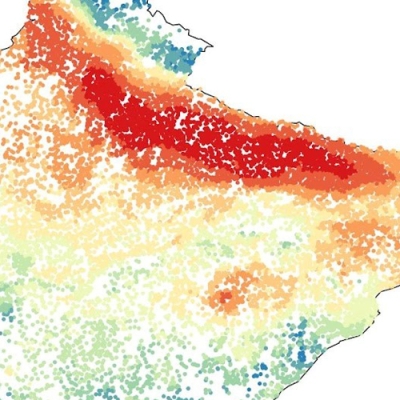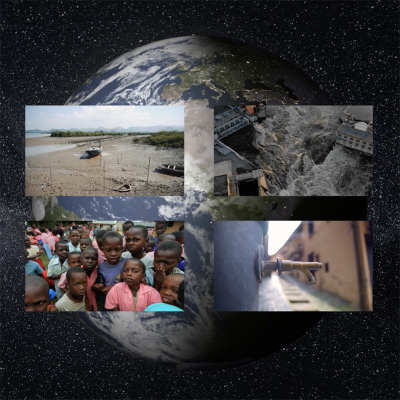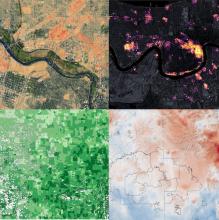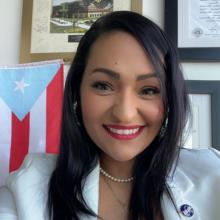Explore Environmental Justice Resources
- Understanding Needs to Broaden Outside Use of NASA Data (UNBOUND)-Environmental Justice workshop
- Environmental Justice Data Catalog
Communities around the world are facing environmental challenges, including poor air and water quality, sea level rise, extreme heat, and more. Marginalized communities, particularly in the poorest and most vulnerable areas, bear the burden of these challenges.
According to the U.S. Environmental Protection Agency (EPA), environmental justice is the fair treatment and meaningful involvement of all people regardless of race, color, national origin, or income with respect to the development, implementation, and enforcement of environmental laws, regulations, and policies. Along with environmental justice, the Environmental Justice Advisory Council further defines environmental justice communities as "geographic locations within the U.S. and its territories with significant representation of persons of color, low-income persons, indigenous persons or members of Tribal nations, where such individuals experience, or are at risk of experiencing, higher or more adverse human health or environmental outcomes." Climate justice, which is related to environmental justice, is an acknowledgement that climate change can result in poor and marginalized communities having a disproportionate exposure and vulnerability to environmental impacts, particularly in developing countries.
NASA data are being used to support environmental and climate justice efforts, as demonstrated by use cases showing how scientists and decision-makers are applying a wide combination of datasets to assess the vulnerability and exposure of communities to environmental challenges. By providing full and open access to the data, software, and tools available through NASA's Earth Observing System Data and Information System (EOSDIS), the agency ensures that anyone can use these resources. In addition, NASA’s Socioeconomic Data and Applications Center (SEDAC) serves as an “Information Gateway” between the socioeconomic and Earth science data and information domains, and provides easy-to-use data in tabular and spatial formats derived from NASA Earth observation data, census data, and other government data sources. These integrated datasets can be used to provide a better understanding of environmental issues and support environmental decision-making to ensure fair and equal treatment for communities.
Using NASA Earth Observation Data to Support Environmental Justice

NASA is making a long-term commitment to create an inclusive open science community, and the agency’s Earth Science Division (ESD) supports environmental justice communities by expanding awareness, accessibility, and use of Earth science data. NASA also is working with non-governmental organizations (NGOs), academia, industry, and other federal agencies to identify readily available Earth science datasets that can be integrated with social science datasets to enable transdisciplinary science. The agency is leveraging existing partnerships with EPA, NOAA, Mercy Corps, Conservation International, and others to address environmental justice challenges and to share resources and knowledge. More information about SMD environmental justice goals is available on the SMD Equity and Environmental Justice webpage.
Through open-source science initiatives, NASA's Earth Science Data Systems (ESDS) Program is making NASA Earth science data more interoperable, transparent, usable, and open. ESDS strives to broaden the impact of NASA's Earth science data by engaging with a diverse community that can use these data for societal benefit and by providing a wealth of resources that can be utilized to better understand environmental and climate-related injustices around the world. Providing these resources fully, openly, and without restriction increases access to knowledge and expands opportunities for new voices to participate in the scientific process. Additionally, sharing the data, code, and knowledge associated with the scientific process lowers barriers to entry for historically underrepresented communities and enables research to be more broadly reproduced.
How NASA Data Help Address Environmental Justice
Along with ground-based observations and field campaigns, NASA uses sensors aboard satellites and aircraft to obtain measurements about Earth's atmosphere, oceans, land, and life. When coupled with socioeconomic data about race, ethnicity, poverty, and health, these observations can help identify environmental challenges that disproportionally impact specific communities. Through NASA's Earth Action Program (formerly the Applied Sciences Program), many of these observations are incorporated into efforts to improve the environmental quality of life in communities around the world. The following use cases highlight how Earth observations are being used to identify areas of environmental injustice and aid decision-makers in their response.
Tropical Cyclones | Sea Level Rise | Water Availability | Extreme Heat | Air Quality | Urban Flooding
Tropical Cyclones
Hurricane Maria and Electricity Recovery in Puerto Rico—A disproportionate share of long-duration power failures occurred in rural communities
In September 2017, Hurricane Maria made landfall in Puerto Rico as a Category 4 storm, devastating the island. Maria was the third costliest hurricane in U.S. history, and the island continues to feel its effects. High wind coupled with a storm surge of 6-9 feet destroyed homes and businesses and flooded many towns. This destruction caused one of the longest electric power blackouts in U.S. history.
NASA researchers used Day/Night Band (DNB) data from the Visible Infrared Imaging Radiometer Suite (VIIRS) aboard the joint NASA/NOAA Suomi National Polar-orbiting Partnership (Suomi NPP) satellite, data from the NASA/USGS Landsat series of satellites, and OpenStreetMap data to monitor restoration of electrical power across the island. They also integrated socioeconomic data of the neighborhoods affected by power outages with the satellite data. An analysis by Universities Space Research Association scientist Dr. Miguel Román and his colleagues found that 41% of Puerto Rico’s rural municipalities experienced prolonged periods of outage, compared with 29% of urban areas. In the six months after Hurricane Maria, Puerto Ricans lost an estimated 3.9 billion hours of access to electric power, with rural communities accounting for 61% of this loss. In the mountainous interior of the island, some residents went without power for more than four months.
The interactive NASA Worldview comparison image below uses Suomi NPP/VIIRS DNB imagery to show the difference in electrical power across Puerto Rico before Hurricane Maria (September 13, 2017; left image) and after the storm (October 30, 2017; right image).
Read more: Night Lights Show Slow Recovery from Maria, NASA Earth Observatory, December 13, 2018.
View the Earthdata Nighttime Lights Backgrounder for additional information about the use of nighttime lights data and for information on the VIIRS DNB and Black Marble datasets, including direct links to these data.
Sea Level Rise
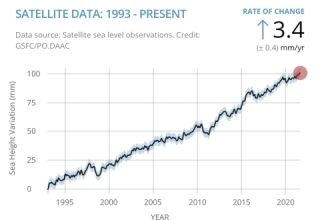
Norfolk, Virginia, and Sea Level Rise—A disproportionate share of affected communities have a population that primarily identifies as Black, low-income, or both
Global mean sea level (GMSL) is rising approximately 3.4 millimeters (0.13 inches) a year, a rate that has grown by 1-2 millimeters (0.04-0.08 inches) per year in most regions over the past century. Because of waves and tides, it’s not possible to "see" a few millimeters of sea level rise a year just by looking at the ocean. However, coastal communities are experiencing the effects through impacts including flooding, erosion, and salinization. Norfolk, VA, is one of these coastal communities. Norfolk, home to the world’s largest naval base, is one of several municipalities comprising Virginia’s Hampton Roads region, which has a population of more than 1.8 million. The sea level around Hampton Roads is rising 4-5 mm/year, according to NOAA data, in part because the land in this region is sinking.
Pairing satellite data, such as sea surface height data acquired by the TOPEX/Poseidon, Jason-1, Ocean Surface Topography Mission (OSTM)/Jason-2, Jason-3, and Sentinel-6 Michael Freilich satellites, with socioeconomic data, such as data from the U.S. Census Bureau, EPA, and SEDAC (including population and U.S. Census statistics of race and poverty level), can show the disparity between communities being impacted. These data from multiple sources can be integrated to enable scientists and city managers to consider social as well as scientific impacts when making decisions about mitigation strategies.
In the interactive Worldview image below, socioeconomic data available through SEDAC are combined with sea surface height anomaly data to show the high population density of the Hampton Roads region and the anomalously high sea surface height. The sea surface height depicted in the image is derived from a combination of satellite altimetry data and historical sea level measurements from tide gauges to create a sea surface height anomaly dataset spanning 1950 through 2009.
Read more: Helping Cities Stay Dry When Sea Levels Rise, NASA Applied Sciences, Space for U.S.
View the Earthdata Sea Level Change Data Pathfinder for additional information about datasets used to assess sea level change, including direct links to these data.
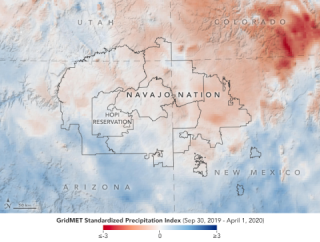
Water Availability
Navajo Nation and Water Resources—At least 70,000 Navajo Nation residents do not have access to potable water in their homes
A remote area in which managing water resources is difficult is the Navajo Nation, which covers more than 70,000 square kilometers (27,000 square miles) in northern Arizona, southern Utah, and northern New Mexico (an area roughly the size of the U.S. state of West Virginia). The reservation, with a 2010 Census population of 173,667, is dealing with periods of severe drought coupled with a lack of domestic water infrastructure and economic resources. According to the 2010 U.S. Census, at least 70,000 Navajo Nation residents do not have access to potable water in their homes.
In partnership with the Navajo Nation, NASA DEVELOP (part of NASA's Applied Sciences Program) supported the creation of a computer application called the Drought Severity Assessment Tool (DSAT). DSAT integrates precipitation data from NASA’s Tropical Rainfall Measuring Mission (TRMM) and the joint NASA/Japan Aerospace Exploration Agency Global Precipitation Measurement (GPM) Core Observatory with other sources to provide Navajo Nation water resource managers reservation-wide historic and near real-time data about their water resources. The tool calculates Standard Precipitation Index (SPI), which is calculated based on a 30-year average of precipitation and is an indication of how much an area’s precipitation deviates from normal. The SPI is used by Navajo Nation water resource managers to identify areas in the reservation experiencing drought and the severity of this drought. These reports determine how Navajo Nation financial resources are allocated to mitigate drought.
NASA's Western Water Applications Office continues this effort through the Navajo Nation Drought Project. The project aims to supplement current data sources with space-based observations to support water resource management in the Navajo Nation.
DSAT has transitioned into a more robust tool, the Drought Severity Evaluation Tool (DSET). Along with TRMM and GPM data, DSET also incorporates data from Landsat (vegetation indices, water indices, and surface reflectance) and the Moderate Resolution Imaging Spectroradiometer (MODIS) aboard NASA's Terra and Aqua satellites (vegetation indices, water indices, evapotranspiration, land surface temperature, and surface reflectance).
Read more:
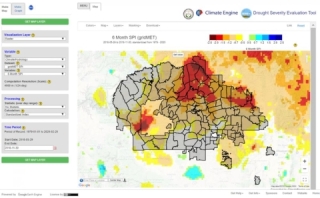
- Navajo Nation Manages a Scarce Resource: Water, NASA Applied Sciences, August 28, 2020.
- A Drought Monitoring Tool for Customized Calculation of a Standardized Precipitation Index Value in the Navajo Nation, Cheryl Cary, Amber Brooks, Clayton Sodergren, and Vickie Ly, DEVELOP, Spring 2015.
- Using NASA Earth Science Data to Help Manage Water Resources in the Navajo Nation: A Data Chat with Vickie Ly, Josh Blumenfeld, NASA ESDS, February 6, 2017.
View the Earthdata Agriculture and Water Resources Data Pathfinder for additional information on datasets used to assess water resources, including direct links to these data.
Extreme Heat
Extreme Heat in New York City—Higher incidences of heat-related deaths in New York City occur in neighborhoods with high poverty and in historical neighborhoods of color
Heat waves are periods of abnormally hot (and possibly humid) weather lasting a few days to weeks at a time. According to the United States Global Change Research Program, heat waves are occurring more frequently in major cities across the nation. In fact, the number of heat waves per year in major cities tripled between 1960 and 2010. Urban heat islands play a role in these extreme heat events. Urban heat islands occur in areas containing more impervious surfaces (such as buildings and paved areas) and fewer natural environments (such as parks and open space). The day and night surface temperatures are higher in urban heat islands than in surrounding areas since these impervious surfaces absorb and retain heat. During heat waves, this can lead to greater numbers of heat-related illnesses and deaths. Data on surface temperature and vegetative change are collected by a number of satellite-borne sensors, including MODIS, VIIRS, and instruments aboard the Landsat series of satellites. These data can be used to help cities mitigate the heat stresses for residents, especially in a warming climate.
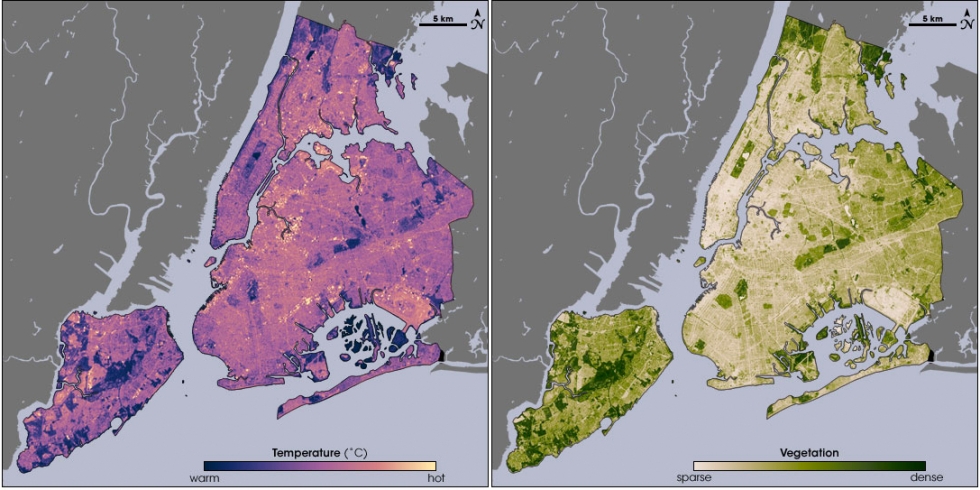
NASA's Applied Sciences Health and Air Quality Program worked with New York State officials and scientists to determine when high temperatures started to negatively affect human health in New York State. The results showed that the state's threshold for alerting the public to extreme heat events needed updating. "Our research found that the health effects associated with temperature in our region actually occurred at lower temperatures than the National Weather Service criteria, which were based on studies in hotter areas of the U.S.," explained Dr. Tabassum Insaf, the research director at the New York State Department of Health's Bureau of Environmental and Occupational Epidemiology. "We worked with the local National Weather Service [office]—they have been great collaborators—and they were very receptive to our research."
Dr. Christian Braneon, a remote sensing specialist at NASA's Goddard Institute for Space Studies and the co-director of the Environmental Justice and Climate Just Cities Network at Columbia University's Earth Institute, has studied this issue in New York City, and found a clear overlap in historical neighborhoods of color and higher surface temperatures. Dr. Braneon stresses the need to understand the distribution of heat within a socioeconomic lens.
"It’s not chance that some communities are taking on a disproportionate burden when it comes to extreme heat," Braneon says. "This is due to racist policies in the past, like segregation and redlining, at least in part, and so we have this amazing opportunity to use all of the datasets at our disposal to undo some of this inequity and create equity." Braneon is working with New York City officials to develop land cover strategies to mitigate heat.
View the Earthdata Disasters Extreme Heat Data Pathfinder for additional information on datasets used to assess extreme heat, including direct links to these data.
Air Quality
Air Pollution in Washington, D.C.—Exposure to harmful air pollutants is higher in areas that have historically had higher percentages of people of color as well as residents with lower household incomes and lower educational attainment
Air pollution kills an estimated seven million people every year, according to the United Nations, making it one of the biggest environmental health risks of our time. While regulations in the U.S. have improved air quality, many cities still face health-related issues due to air pollution. Suspended particulate matter 2.5 microns or less in diameter (designated PM2.5) can penetrate deep into the lungs, causing respiratory issues and other health concerns (in comparison, a human hair is about 50 to 70 microns in diameter). PM2.5 levels in Washington, D.C., have declined by roughly 50% since 2000; however, the health benefits have not been equal across the city.
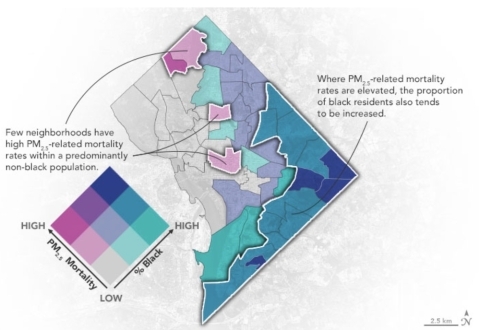
In a recent study, researchers from George Washington University, the D.C. government, Boston University, Washington University in St. Louis, and Dalhousie University in Nova Scotia, Canada, correlated health record information with air quality data acquired by instruments aboard NASA satellites and ground-based stations maintained by the D.C. Department of Energy and Environment. The research team found that exposure to PM2.5 was greater in areas of the city that had higher percentages of people of color as well as residents with lower household incomes and lower educational attainment.
The satellite PM2.5 dataset was developed by researchers from Washington University in St. Louis and Dalhousie University using observations from the Moderate Resolution Imaging Spectroradiometer (MODIS) aboard the Terra and Aqua satellites, the Multi-angle Imaging Spectroradiometer (MISR) aboard Terra, and the Sea-viewing Wide Field-of-view Sensor (SeaWIFS) aboard the OrbView-2 (SeaStar) satellite. They also incorporated information from NASA's Goddard Earth Observing System (GEOS)-Chem model, which is a global 3-D model of atmospheric chemistry. Researchers found that rates of pulmonary disease and stroke were five times higher in D.C.'s poorer southeastern quadrant compared with rates from its more affluent northwestern quadrant. Additionally, rates of ischemic heart disease, in which the heart does not receive enough blood and oxygen, were nine times higher and asthma-related emergency room visits were 30 times higher in the city's southeast quadrant.
Read more: An Extra Air Pollution Burden, NASA Earth Observatory, November 9, 2021.
View the Earthdata Air Quality Data Pathfinder for additional information on datasets used to assess air quality, including direct links to these data.
Urban Flooding
A NASA SEDAC study created a tool to help identify flood-vulnerable communities in Harris County, Texas, and inform the equitable prioritization of flood resilience activities, focusing on communities most-at-need
Harris County is the third most populous county in the U.S. and is home to the fourth most populous U.S. city—Houston. If the City of Houston were a state, its 2020 Census population of 2.3 million would rank it 36th in size based on population, placing it behind Kansas and ahead of New Mexico.
Urban sprawl in Harris County's urban core and in adjacent areas is making the county increasingly prone to flooding due to increased precipitation, its low topography, and land-use change. Between 1997 and 2017, approximately 200-square miles of land in Houston were developed and 30% of Houston's wetland area was lost due to development. This rapid urbanization and land use change has caused the loss of spongy, water retaining marshes and prairies that helped contain periodic flooding, increasing the city's flood risk and the number of residents exposed to the threat of flooding.
"Everyone in Harris County deserves flood protection, but we don't have any tools in place to be able to understand where those worst hit areas are and where we have those pockets of highest vulnerability," says Iris Gonzalez, director of Houston's Coalition for Environment, Equity & Resilience (CEER). CEER is a nonprofit organization "committed to uniting and empowering people to protect and restore the natural resources of the Gulf Region."
To help create a tool for assessing relative flood vulnerability across Harris County, NASA's SEDAC—in partnership with the International Research Institute for Climate and Society (IRI) at Columbia University—developed a flood vulnerability index for the county that captures social and economic factors influencing flood vulnerability at the highest spatial resolution.
A multidimensional vulnerability approach was used to capture resilience and susceptibility to flooding, with the acknowledgement that what makes populations vulnerable differs over space. The project began with a review of the literature on variables influencing flood vulnerability, followed by meetings with community stakeholders and experts to receive input on indicators applicable to Harris County. The SEDAC team mapped and analyzed these individual vulnerability indicators, including percent of Harris County residents below the poverty line, number of single parent households, lack of internet and vehicle access, and lack of a high school diploma. A set of 15-indicators was selected and combined into an aggregate index. This allowed for spatial visualization of flood vulnerability at the block group level for Harris County and an analysis of relative flood vulnerability across the region.
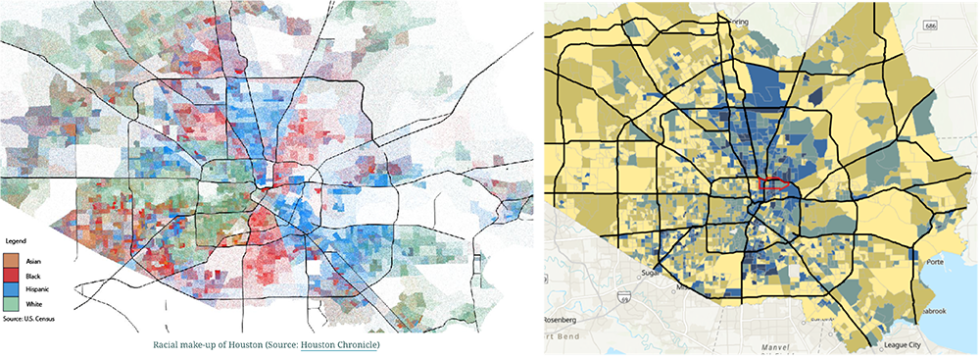
It is critical that equity and justice are central to the policies, programs, and decision-making processes that determine which communities get invested in—made more flood-resilient—and which do not. Colleen Neely, who holds an MPA in Environmental Science and Policy from Columbia University and performed this research as a graduate student, said "Using high resolution data and engaging community stakeholders to select vulnerability indicators representative of conditions within a community can help meet this need, ultimately helping advance environmental and social justice."
In evaluating the flood vulnerability index, the SEDAC and IRI team looked specifically at one community—Kashmere Gardens, a Black and low-wealth community in Houston's urban core. As a potential indicator of flood vulnerability, this community had one of the highest numbers of high-water rescue calls during Hurricane Harvey in 2017. SEDAC and IRI's flood vulnerability map corresponds with this, also showing this community to be amongst the highest in relative flood vulnerability within Harris County. Additionally, the higher resolution of the SEDAC and IRI map shows nuances and pockets of greater vulnerability not evident in lower resolution social vulnerability maps, such as a similar map produced by the Centers for Disease Control and Prevention (CDC).
Read more: Understanding Flood Vulnerability: A Case Study of Harris County, NASA SEDAC, April 20, 2021.
View the Earthdata Disasters Floods Data Pathfinder for additional information on datasets used to assess pre-flood conditions and flood inundation mapping, including direct links to these data.
Supporting Citizen Science and Scientists through Projects Furthering Environmental Justice
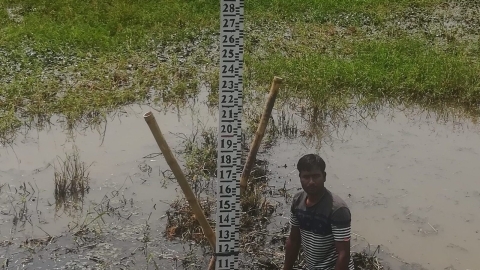
The ESDS Citizen Science for Earth Systems Program (CSESP) supports public involvement in numerous NASA-funded projects with a focus on environmental justice.
The Lake Observations from Citizen Scientists and Satellites (LOCSS) CSESP project is a global effort to explore how water levels in lakes is changing. As part of this project, citizen scientists are extending the resolution and coverage of data on the level of lakes in Bangladesh that are important for drinking water, flood control, and food, especially in underserved communities. LOCSS data contributed to the Bangladesh government's exploration of ways to improve water security more equitably for residents along with the government's investment in a country-wide network of 50 gauges to monitor the impact of the Delta Plan 2100 using LOCSS-derived techniques.
Another CSESP project, Community Eyes on River Ice, is partnering with Alaska indigenous tribes and other stakeholders to produce a long-term dataset to inform tribal climate adaptation planning for changing river ice conditions. Warmer winters have rapidly altered freshwater ice conditions in Alaskan river basins. Changes in ice thickness and the timing of freeze-up and break-up influence hydrology, ecosystems, winter travel safety, access to subsistence resources, and spring ice-jam flooding. The project aims to expand existing freshwater ice monitoring efforts within Alaska using a culturally-responsive citizen science model to increase the spatial extent and frequency of observations and expand the diversity of participants collecting these data. The work is being conducted through a partnership with the Tanana Chiefs Conference (a regional Alaska Native nonprofit charged with advancing tribal self-determination and enhancing regional native unity across 42 member tribes in interior Alaska), the University of Alaska Fairbanks, the National Weather Service Alaska Pacific River Forecast Center, and NASA GLOBE Observer.
Finally, the CSESP project Can Citizen Science and Low-Cost Sensors Help Improve Earth System Data? is recruiting citizen scientists, including those in environmental justice communities, to deploy a low-cost fine particle (PM2.5) sensor network. Participants are located in environmental justice communities disproportionately impacted by major sources of air pollution such as petroleum refineries, ports and warehouses, and major highways.
Information about these and other CSESP projects is available through the Earthdata website.
Along with CSESP, another NASA-supported citizen science effort is the Global Learning and Observations to Benefit the Environment (GLOBE) Program. GLOBE is an international science education program that provides opportunities for students and the public to contribute to our understanding of the Earth system and global environment. NASA is the lead agency for GLOBE, with the U.S. State Department, NOAA, and the National Science Foundation as partners. A NASA-funded GLOBE initiative called GLOBE Mission EARTH (GME) is a collaborative effort that includes partner academic institutions across the U.S., teachers, students, and citizen scientists. The GME goal is to improve science, technology, engineering, and mathematics (STEM) education in disadvantaged student populations by encouraging participation in the GLOBE Program and through the utilization of NASA assets.

As part of GME, Dr. David Padgett, a GLOBE trainer and an associate professor of geography at Tennessee State University (a GME partner), worked with Detroit’s Green Door Initiative to design a climate justice learning experience for Detroit youth. Since its establishment in 2010, the Green Door Initiative has worked to foster environmental justice in Detroit and improve infrastructure to help save neighborhoods in poverty. Youths participating in the learning experience designed by Padgett used GLOBE observations along with NASA and other environmental data to compare the urban heat island effect across Detroit communities. They found that the lowest-income neighborhoods and neighborhoods of color were disproportionately impacted.
Finally, NASA Distributed Active Archive Centers (DAACs) are part of the World Data System (WDS), which promotes the long-term stewardship of, and universal and equitable access to, quality-assured scientific data and data services, products, and information across all disciplines in the natural and social sciences as well as the humanities. NASA SEDAC deputy manager and WDS scientific committee chairperson Dr. Alex de Sherbinin led a task group to study the value of citizen science data and the data-related practices of the citizen science community. These data are high value for environmental justice and community empowerment, especially when combined with NASA and other secondary data.

